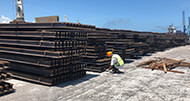
Global Solutions For Business
Linking Expertise and Resources
Diverse and Extensive Market Reach
 Trains don’t just connect locations; they connect lives. The route of a train can help determine the future of businesses, neighborhoods and towns, just by where the train travels through and where it stops. More practically, a railway network can have positive, progressive effects on a region’s economy through efficient passenger transportation and cargo service, as well as generating jobs in its own sector and ancillary businesses.
Trains don’t just connect locations; they connect lives. The route of a train can help determine the future of businesses, neighborhoods and towns, just by where the train travels through and where it stops. More practically, a railway network can have positive, progressive effects on a region’s economy through efficient passenger transportation and cargo service, as well as generating jobs in its own sector and ancillary businesses.
Sumitomo Corporation de Mexico, S.A. de C.V. (SCMX), in cooperation with SCOA and Sumitomo Canada Limited (SCL), was awarded the contract to supply nearly 60,000 tons of rail for two separate sections of the seven-section rail system known as Tren Maya, a new 948-mile intercity railway under construction in Mexico that looks to be an economic game-changer for this region. SCMX has already scheduled product delivery for each section, with 2,626 tons of rail having arrived in Puerto Progreso on September 25. And, in October, the rails for Tren Maya’s Section 5 were transferred by land to site in Tulum using transportation coordinated by SCMX.
Traversing the Yucatán Peninsula via two routes that encircle the peninsula and divided into seven different sections, the new train line will pass through 29 stations in the five principal south-east states of Chiapas, Tabasco, Campeche, Yucatan, and Quintana Roo.
 Aiming to connect tourist destinations in the Yucatán, including historic Mayan sites from which it derives its name, the $7 billion transportation project serves as the largest infrastructure development in decades and the flagship project of the current Mexican government. With main objectives of increasing tourism and reinvigorating the economy of the region, the project will generate at least half a million jobs. All participants are committed to completing the first section of the intercity railway project by 2023.
Aiming to connect tourist destinations in the Yucatán, including historic Mayan sites from which it derives its name, the $7 billion transportation project serves as the largest infrastructure development in decades and the flagship project of the current Mexican government. With main objectives of increasing tourism and reinvigorating the economy of the region, the project will generate at least half a million jobs. All participants are committed to completing the first section of the intercity railway project by 2023.
Mexico’s National Fund for the Promotion of Tourism (Fonatur) has led the project, a high priority for the government’s passenger and freight rail progress agenda. The first phase of the project involving sections one to four will connect the stations from Palenque to Cancun, while the second phase involving the remaining three sections will cover the stations from Cancun to Escarcega.
“The biggest obstacle to overcome in our attempts to land this contract involved the business culture differences,” according to Mauricio Benavides, General Manager and Head of SCMX Steel Department, “since we are dealing with a public company that belongs to the Mexican government, and trying to strike a balance between their business culture and ours. As a result, we won contracts for two tenders. Our part of the project is divided in Sections 3 and 5, so together, we will deliver 60,000 tons of rail in total, with the delivery to be completed in May 2022 as per the contract terms and conditions.”
 Benavides credits much of the success to the hard work of his SC Mexico team, which included Ricardo Santiago, Sales Manager; Jun Kojima, Sales Manager; Christopher Pantoja, Sales Assistant Manager; Vanessa Garcia, Sales Assistant; and Valeria Reyes, Sales Assistant. However, the coordination of this multinational, interdepartmental effort maximized SCOA, SCL and SCMX’s steel expertise through open communication and long hours.
Benavides credits much of the success to the hard work of his SC Mexico team, which included Ricardo Santiago, Sales Manager; Jun Kojima, Sales Manager; Christopher Pantoja, Sales Assistant Manager; Vanessa Garcia, Sales Assistant; and Valeria Reyes, Sales Assistant. However, the coordination of this multinational, interdepartmental effort maximized SCOA, SCL and SCMX’s steel expertise through open communication and long hours.
“Connectivity, perseverance and integrated corporate strength helped us work toward a winning bid,” Benavides said. “This involved a great deal of work, months before the tender’s release. We created a special team for the Tren Maya bid, led by me, with assignments divided with the goal to be more efficient. We reinforced the working team’s mission and made sure everyone had a clear idea that we would win through not just hard work, but positive and constructive thinking.”
Mike Nakawatase, Deputy General Manager and Vice President of SCOA Steel & Non-Ferrous Metals Group, agreed that connecting the three country’s business strengths was a recipe for success.
“Sharing SCOA and SCL’s knowledge and decades of experience in the rail industry, plus SCMX’s persistent and diligent efforts lead to a project that will enhance the lifestyle of thousands and contribute to Mexico’s rising economic prominence in the Americas,” he commented.
 SCOA Senior Corporate Counsel Diana Rosales, a member of the bid proposal’s legal team, said that contract bids for projects of this magnitude require untangling a tremendous amount of complexities, creating questions from all sides, and she is proud of the team’s accomplishment.
SCOA Senior Corporate Counsel Diana Rosales, a member of the bid proposal’s legal team, said that contract bids for projects of this magnitude require untangling a tremendous amount of complexities, creating questions from all sides, and she is proud of the team’s accomplishment.
“Understanding that this was our first bid with the Mexican government, I believe the team did incredibly well based on the information we were supplied for this project,” Rosales stated. “We won the contracts.”
Chiapas, Campeche, and Quintana Roo have unemployment rates near the national average, while that of Yucatán is lower; Tabasco stands out with an unemployment rate of 6.2%, the highest in the country. Local communities will benefit from the improvement of urban infrastructure and public services associated with the project. For members of SCMX to be a part of a project that brings transportation and jobs to much of the underserved Mexican populace is an added bonus for his team, Benavides said.
“This is an honor for us, because this is the main project for the current Mexican government’s plan,” he said. “We are shining a light on Mexico’s infrastructure problems and solutions inside of our organization, as well as giving us exposure in Mexican media as one of the project suppliers.”
When it comes to transportation projects, it looks as though the final destination of Tren Maya will be success, progress and a better-interconnected Mexico.
Tren Maya aims to generate hundreds of thousands of jobs for people in the region, and local communities will benefit from the improvement of urban infrastructure and public services associated with the project.
SCMX has already scheduled product delivery for each section, with 2,626 tons of rail having arrived in Puerto Progreso on September 25. In October, the rails for Tren Maya’s Section 5 were transferred by land to Tulum using transportation coordinated by SCMX.